Samsung Galaxy J5 (2016) Review
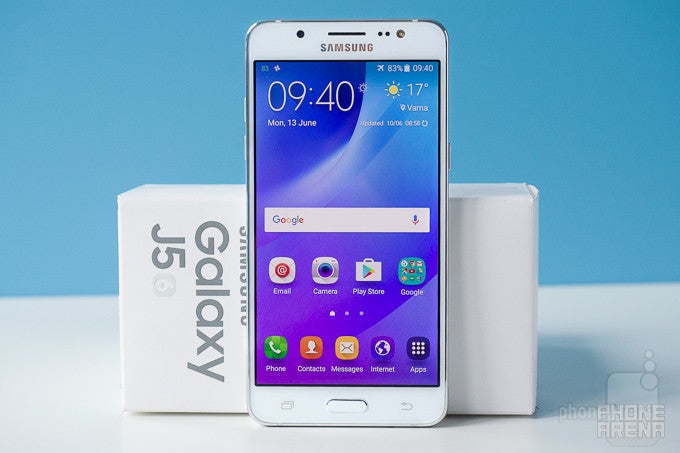
Introduction
When we think of Samsung, it's usually the flagships like the Galaxy S7 edge and Galaxy Note 5 that immediately come to mind. However, it's not really these flashy and expensive models that sell by the buckets. Rather, it's the less design- and specs-intense ones from budget series like the Galaxy J and Galaxy A that make up the bulk of Samsung's smartphone shipments.
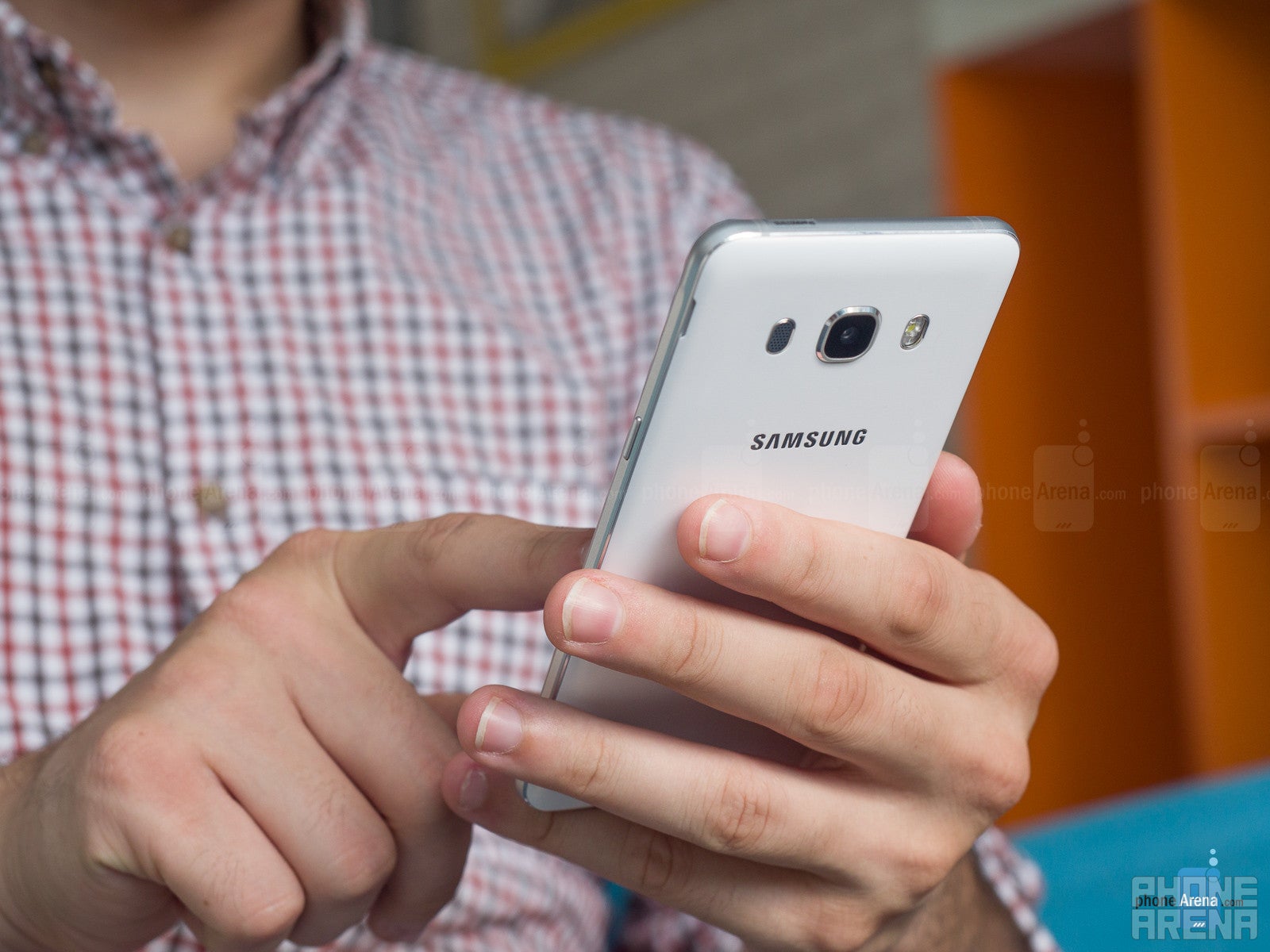
Design
An elegant smartphone whose budget origins aren't immediately obvious.
With its symmetric and tastefully sculpted metal frame, the J5 (2016) is worthy of the Galaxy branding. While the removable plastic back panel does reveal the handset's cost-efficient origins, nothing about the construction feels like an afterthought. The handset feels tightly put together and reasonably comfortable in the palm with its sculpted edges and balanced weight. We think the power and volume keys are placed a tad too high, but we can live with this. The keys handle fine, and so does the Home button below the screen, which doesn't contain a fingerprint sensor, but it can swiftly launch the camera app in two quick presses.
True to Samsung form, the Home button is accompanied by capacitive keys – 'Menu' on the left and 'Back' on the right. Also of note is the presence of an actual LED flash next to the selfie camera. Very few smartphones offer that, and we'll tell you more about it later. On the back panel resides a bumpy camera with a single LED flash on the right, and speaker holes placed to the left. The latter looks out of place, but the decision probably has more to do with sound quality than aesthetics.
Below, we find a mic, a microUSB port, and – praise the skies – a 3.5mm jack. This completes the Galaxy J5 (2016)'s favorable, but not class-leading appearance.
Display
Despite its low resolution, the screen offers very good image quality.

A 720p-resolution screen like the one on the Galaxy J5 (2016) doesn't sound very compelling in the age of ubiquitous 1080p screens. But tell you what, this 5.2-inch Super AMOLED looks surprisingly good. Image quality is sharp and clear, while the various display modes let you quickly switch between color-accurate or larger-than-life hues. Although colors are close to home, the screen does exhibit unremarkable contrast, with whites being brighter than needed and causing a slightly washed-out look. The maximum brightness output isn't strong enough for comfortable usage in bright sunlight, and different viewing angles tend to skew the colors. Still, the J5 (2016)'s screen performs admirably for the price point.
Interface
TouchWiz is reasonably accomplished, but still poorly optimized.
While the Galaxy J5 (2016) ships with a dated Android 5.1 Lollipop version, it is treated to the latest security patches, which is fairly reassuring. It is skinned with Samsung's bespoke TouchWiz interface, which has evolved into a straightforward and visually cohesive, but ever so unoptimized user experience over the years.
While users will be missing out on Android 6.0 Marshmallow features such as Google Now on Tap, granular app permissions control, and Android Pay, the software's only significant flaw is performance. The Galaxy J5 (2016) lacks the fluidity and responsiveness of similarly priced devices running lighter Android builds. Your actions will be accompanied by light to obvious stutter, which is especially evident in animations and scrolling.
This unsavory part aside, we commend Samsung for not piling up bloatware applications on the handset. The little in the way of stock software, such as the Galaxy Apps store and the Smart Manager maintenance app, we find useful.
Processor and Memory
Underwhelming performance shows Samsung needs to step up the J series' hardware game.
The handset is based on Qualcomm's Snapdragon 410 chipset, which is designed to be low-cost and energy-efficient. It's paired with 2GB of RAM and 16GB of expandable internal storage. This provides the minimum amount of power for adequate casual use and very little beyond that. 3D games like Asphalt Nitro are playable, but image quality is downgraded and gameplay generally stutters. Less-intense titles like Candy Crush Saga will be good to go, though.
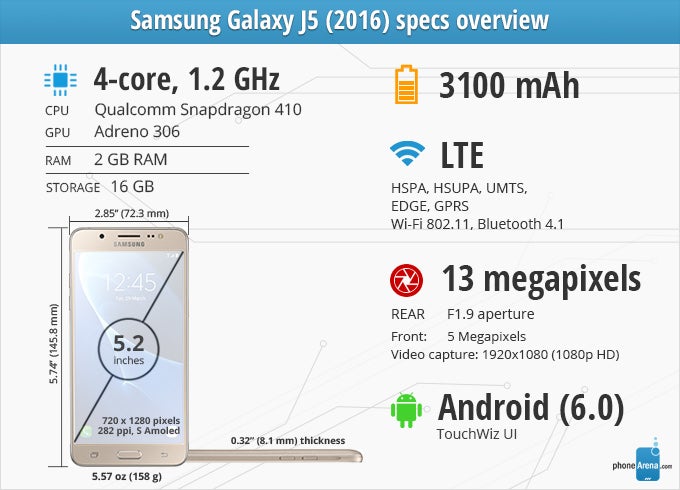
Connectivity
No LTE in the States aside, the Galaxy J5 (2016) doesn't have significant shortcomings.
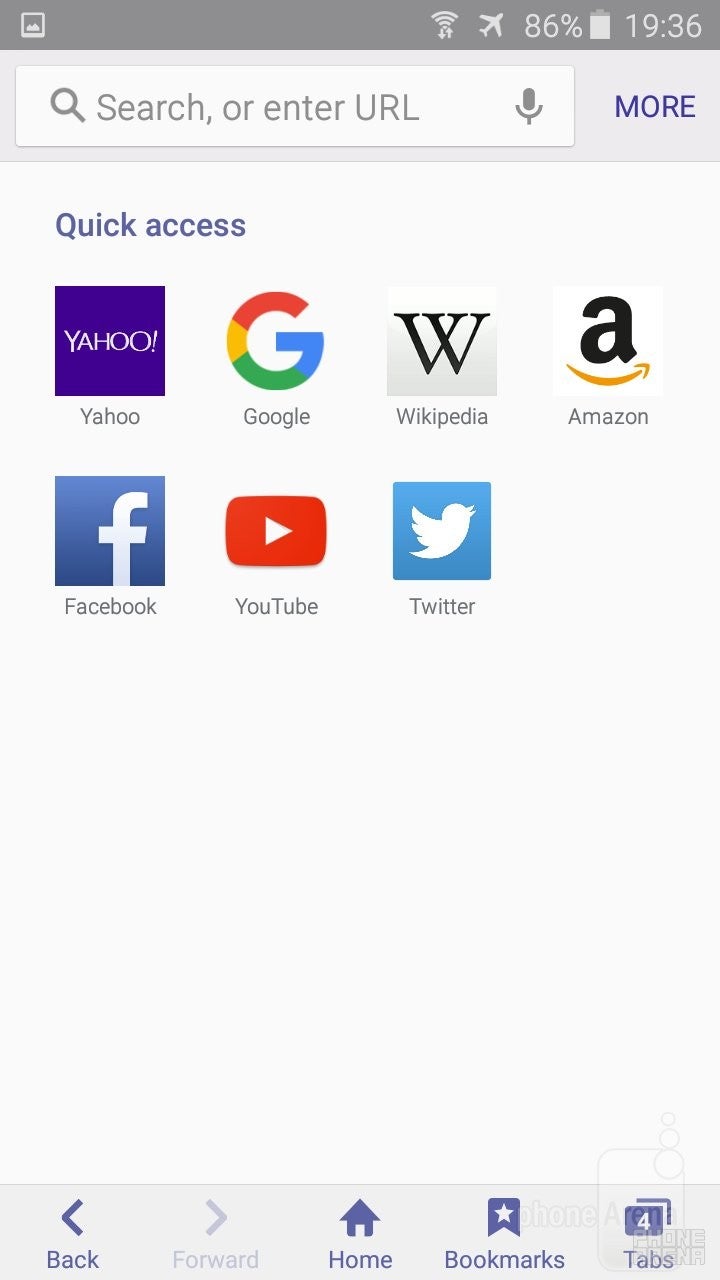
Browser
Other than the limited network support, the phone presents a well-rounded connectivity package courtesy of its Qualcomm modem. The handset offers USB 2.0, Bluetooth 4.1, GPS/Glonass/Beidou navigation, 802.11 b/g/n 2.4GHz Wi-Fi, and NFC. It also features accelerometer, light, and proximity sensors.
Browsing on the Galaxy J5 (2016) is good for the most part. No matter if you're using the stock browser or the bundled Google Chrome, pages load reasonably fast and navigation is fairly smooth, considering the handset's limited performance.
Camera
A surprisingly capable camera is undermined by somewhat inconsistent performance.
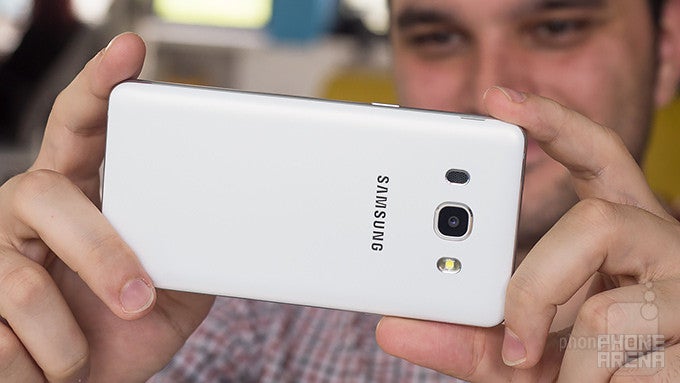
Knowing customers' love for photography, Samsung equipped the Galaxy J5 (2016) with a competent camera setup. The rear unit has a 13MP CMOS sensor with wide f/1.9 aperture and a single LED flash. The front camera is a 5MP unit with f/1.9 aperture and, notably, a dedicated LED flash. So, how does the Galaxy J5 (2016) fare?
Samsung's camera app can be called up quickly by double-pressing the Home button. It performs fast enough to not be a hindrance and it takes proper advantage of the sensor by presenting manual controls and 'crowd pleaser' modes like 'Beauty face', 'Sound & shot', and 'Sports'. The omission of HDR photos is questionable, though.
The photos we took on a fine sunny day left us pleasantly surprised. The Galaxy J5 (2016) captures rich (though over-saturated) colors and clear details. Landing a decent shot with it is easy, but it didn't take too long for the camera to reveal its flaws. Notably, it struggles to expose images correctly upon manually tapping to focus. We faced a lot of “burnt” skies, flower petals turned to glowing halos, and overly darkened objects due to its inconsistency. But, all things considered, the J5 (2016)'s camera does punch beyond its price tag.
Indoor shots revealed another inconsistency in the form of poor focus. No matter how precisely we tapped the areas we wanted to get in focus, we often ended up with blurry and badly exposed images. That's not to say the J5 (2016)'s camera is a total dud indoors, but its performance in this scenario doesn't hold a candle to its outdoor photography abilities.
However, if artificial light is strong and abundant, the camera will bring the goods, at the expense of slightly washed-out colors. It also produced quite satisfactory results in complete darkness, thanks to engaging the flash. The noise filtering is handled remarkably well and the LED's illumination is strong and even. We also tried the selfie flash, concluding that its presence is undermined by the poor front cam which doesn't focus reliably and outputs soft, smeary photos. Moreover, experiencing a strong LED flash inches from your eyes quickly explains why the majority of smartphone makers stay away from the diodes-in-your-face approach, choosing gentle screen-based flashes instead.
Video recording
The Galaxy J5 (2016)'s cameras record videos in up to 1080p/30FPS resolution. Unsurprisingly. 4K video recording and playback is unsupported. The image quality is decent, but the videos are very shaky due to weak image stabilization. The tap-to-focus feature takes its sweet time to get objects in front of the lens in focus, sometimes failing to do so after repeated attempts. The camera is also slow to return to focus once the near-distance object is moved out of the way. Sound quality is good, although the noise filtering comes off as too subtle and loud blasts of racket aren't properly attenuated. As a whole, this is a functional, but underwhelming camcorder.
Multimedia
Other than limited gaming potential, the Galaxy J5 (2016) has nothing to stand in the way of joy.
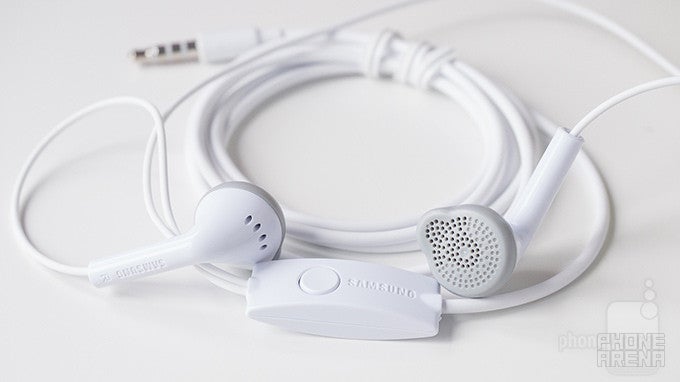
The 5.2-inch display's 720p resolution doesn't get in the way of enjoying photos, videos, games and browsing on the Galaxy J5 (2016). The screen is appropriately sized and the four different display modes let you make the most of its qualities, dialing up the color intensity for movies or bringing them back to reality when showcasing photographs and artworks. The headphone amplifier and loudspeaker are also sufficiently powerful for most users' needs.
Call Quality
A good phone to make calls with.

Battery Life
A long-lasting battery, but also one that takes ages to fill up.
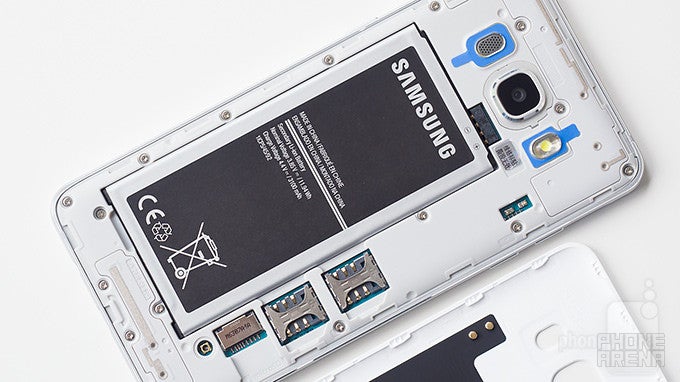
A battery life champion the J5 (2016) is not, but it is among Samsung's longer-lasting Galaxy phones with the 8 hours and 41 minutes of constant on-screen use we recorded in our custom battery taste. This excellent result is achieved courtesy of a large 3100mAh battery, a low-resolution and inherently economical AMOLED display, and a frugal chipset. Alas, the phone is very slow to charge, taking 153 minutes to fill up with the bundled charger.
Conclusion
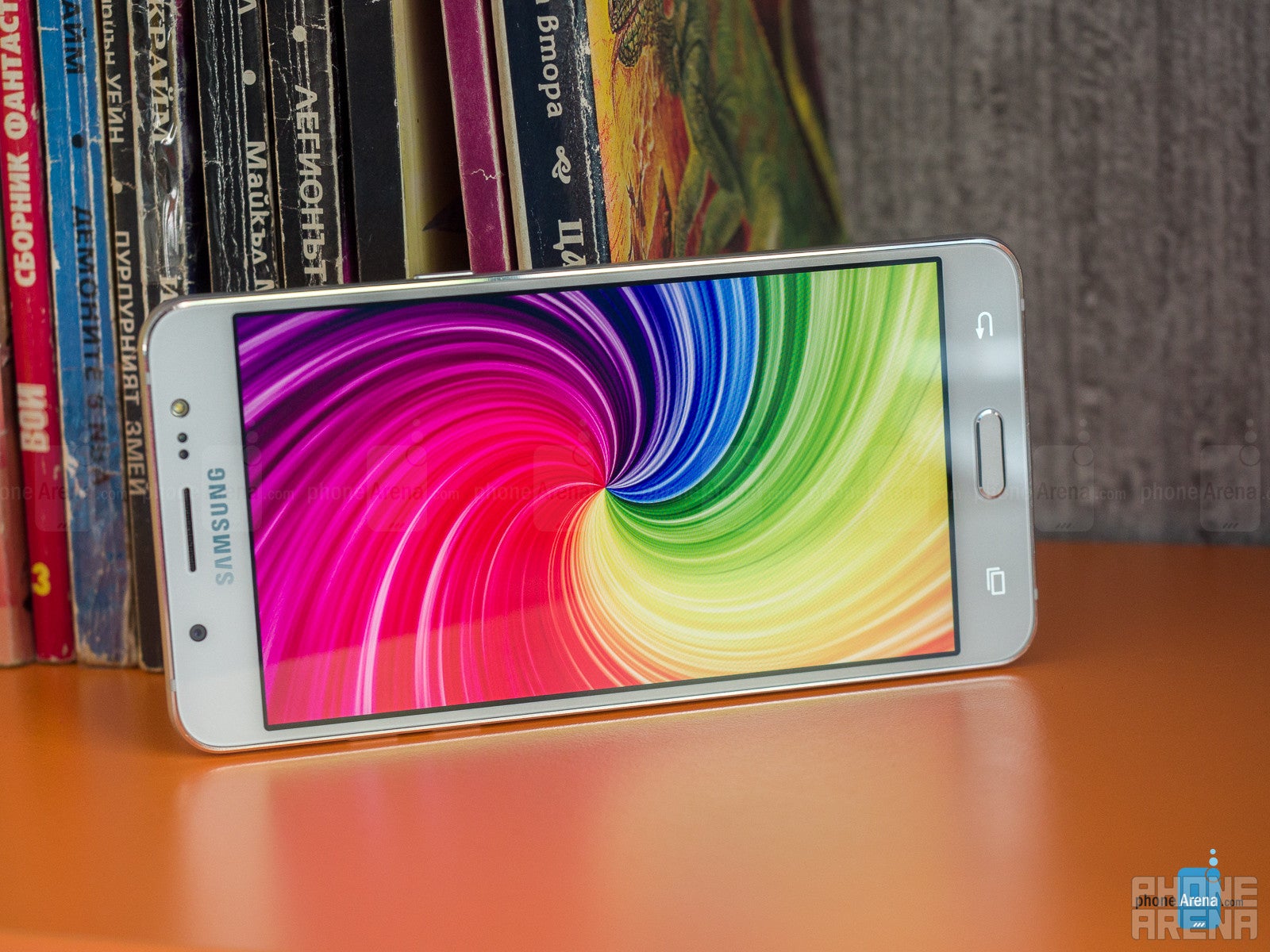
In Asia, handsets like the Meizu M3 Note and Xiaomi Redmi Note 3 offer metal bodies, bigger and higher-res screens, and faster performance without passing the $200 mark. And over in Europe, one can find excellent mid-range phones like the Huawei P9 Lite and LG Nexus 5X, both better in almost every way and priced in the €250-290 ballpark. Next to these, the Samsung Galaxy J5 (2016) doesn't really look that impressive.

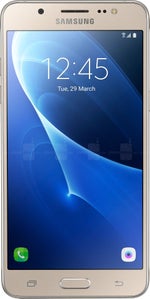


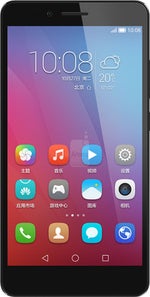

















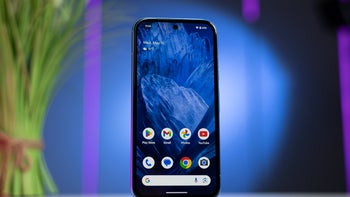


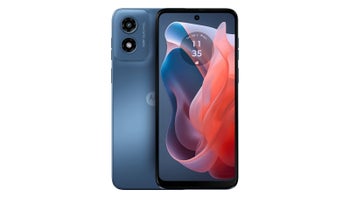


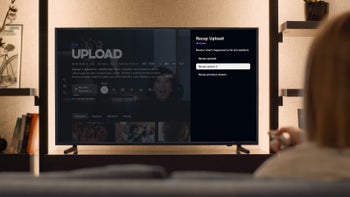
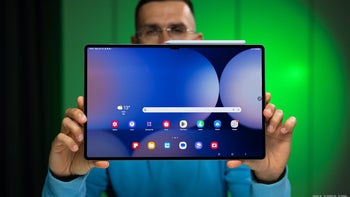
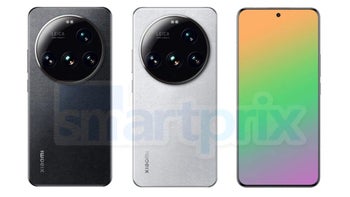



Things that are NOT allowed: